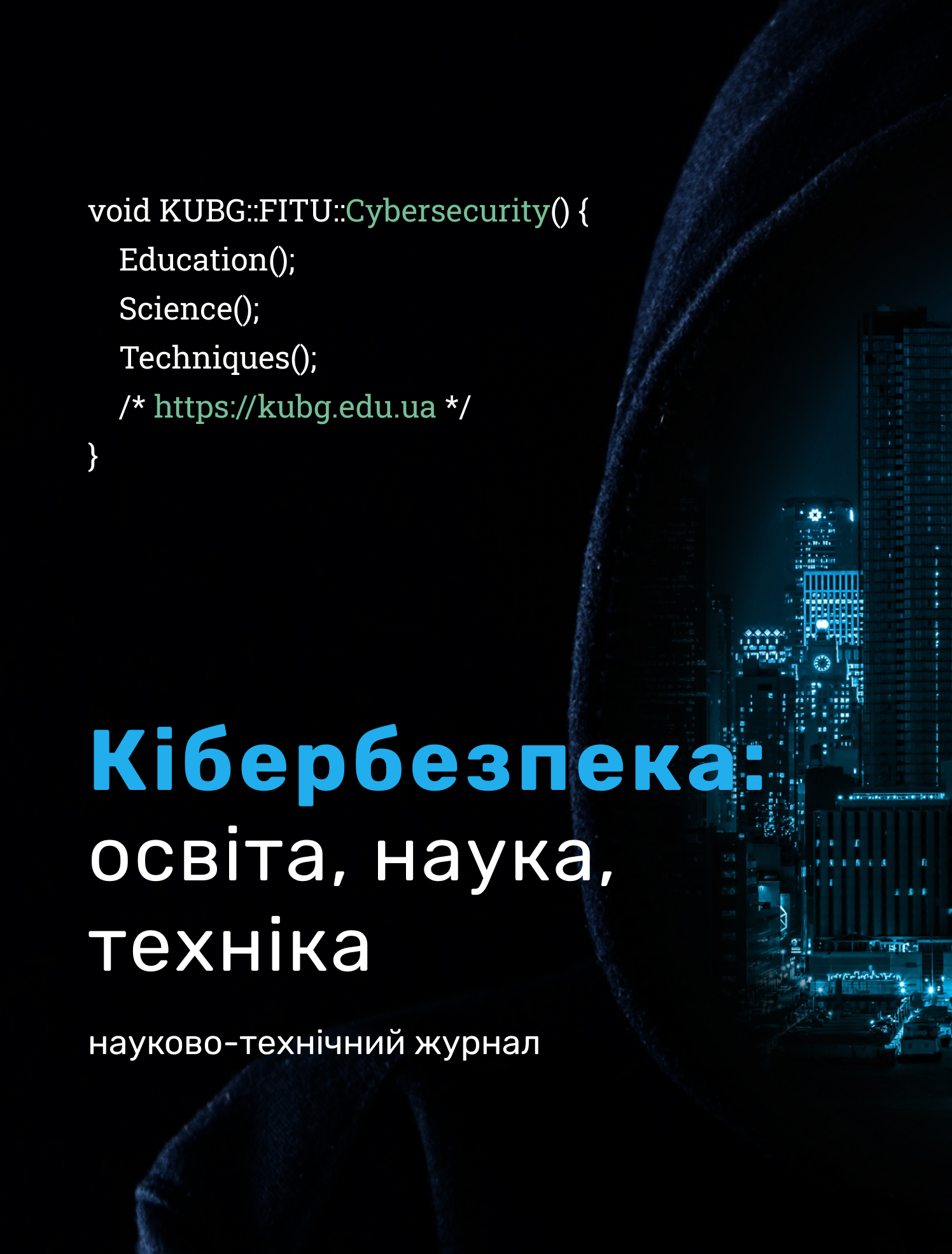ВІД ОБІЗНАНОСТІ ДО УПРАВЛІННЯ: КОНЦЕПЦІЯ ЛЮДСЬКИХ РИЗИКІВ В СИСТЕМІ КІБЕРЗАХИСТУ
DOI:
https://doi.org/10.28925/2663-4023.2025.30.895Ключові слова:
захист інформації; кібербезпека; людський фактор; інформаційна система; інформаційні технології.Анотація
Автори наукової статті звернули увагу, що незважаючи на війну в Україні суспільство адаптувалося до епохи інформаційних технологій, комп'ютеризація і автоматизації, цифровізація охопила всі аспекти життя людини. Концепція держава в смартфоні все більше реалізовується на різні державні послуги для населення. Послуги із соціальної сфери активно трансформується і застосовуються навіть у військовій сфері. Однак з ростом цифровізації виникає потреба розробляти контрзаходи з зміцнення інформаційної та кібербезпеки, і в першу чергу через людський фактор. Метою статті є вивчення психолого-педагогічної проблеми людського чинника забезпечення інформаційної безпеки та кібербезпеки. Результат дослідження. Проблема людського ризику у професійній діяльності не є новою. Людський фактор, закономірності та індивідуальні фактори, що впливають на професійну діяльність, її вплив на результат діяльності вивчалися теорією професійної психології. В епоху інформаційних технологій людський фактор є джерелом нових небачених раніше загроз. Як засвідчує сучасна практика, у гібридній війні супротивник до 90% інформації здобуває завдяки соціальної інженерії, отримує цінну інформацію через соціальні мережі (Facebook, Telegram-канал, Instagram, WhatsApp, Meta, YouTube), що була передана через необережні розмови. Ось чому досвідчені світові команди з кібербезпеки замислилися над рішенням задачі про зменшення людського ризику в інформаційній системі задля збереження захисту інформації та кібербезпеки. Так започаткувалася теорія управління людськими ризиками, поняття яке закріплене як окрема категорія, незалежне від навчання з підвищення обізнаності в галузі безпеки, управління людськими ресурсами обіцяє забезпечити більшу віддачу від інвестицій, ніж будь-яка інша стратегічна ініціатива в галузі безпеки. За результатами дослідження стає очевидним потреба впроваджувати «управління ризиками, пов’язаними з людським фактором». Управління ризиками для людини слід зосереджувати на результатах, а не лише на дотриманні вимог та кількісно визначати ризик, пов'язаний з людською поведінкою. Теоретичні та практичні результати, що одержані в процесі наукового пошуку, становлять підґрунтя для подальшого її вивчення в різних аспектах.
Завантаження
Посилання
How Much Time Do People Spend on Their Mobile Phones in 2017? (2017). Hackernoon. https://hackernoon.com/how-much-time-do-people-spend-on-their-mobile-phones-in-2017-e5f90a0b10a6
Information security: types of threats and methods of their elimination. (2024). Datami. https://datami.ee/ua/blog/informatsijna-bezpeka-vidi-zagroz-i-metodi-yih-usunennya
Pugachev, O. I. (2024). Problems of ensuring information security of Ukraine in modern conditions. Problems of Modern Transformations. Series: Law, Public Administration and Management, (12). https://doi.org/10.54929/2786-5746-2024-12-02-15
Zgurovsky, M. (2000). Problems of information security in Ukraine, ways to solve them. Legal, Regulatory and Metrological Support of the Information Security System in Ukraine: Scientific and Technical Collection, 1, 10–14.
Ostroukhov, V., & Petryk, V. (2008). To the problem of ensuring information security of Ukraine. Political Management, 4(31), 135–141. http://dspace.nbuv.gov.ua/handle/123456789/59848
Bodrov, V., & Orlov, V. (1998). Psychology and reliability: Man in technique control systems. Moscow: Institute of Psychology of the RAS.
Poyda-Nosyk, N., Kálmán, B. G., & Malatyinszki, Sz. (2024). The human factor of information security: Phishing in cybercrime. Acta Academiae Beregsasiensis. Economics, 6, 223–234. https://doi.org/10.58423/2786-6742/2024-6-223-234
Law of Ukraine. (2017). On the basic principles of ensuring cybersecurity of Ukraine. https://zakon.rada.gov.ua/laws/show/2163-19
Zanyk, O., & Tkachuk, R. (2020). The influence of the human factor on information security organization systems. Information Security and Information Technologies: Collection of Abstracts of the IV All-Ukrainian Scientific and Practical Conference of Young Scientists, Students and Cadets, 21–22.
Laboratoriya Kasperskogo: polovina kiberincidentov proishodit iz-za chelovecheskogo faktora. (2017). Agentstvo mezhdunarodnoj informacii Trend. https://www.trend.az/business/it/2819279.html
The Human Factor in IT Security: How Employees are Making Businesses Vulnerable from Within. (2017). AO Kaspersky Lab. https://www.kaspersky.com/blog/the-human-factor-in-it-security/#:~:text=against%20cyberattack%20is%20their%20own,IT%20security%20strategy%20at%20risk
Levchenko, O. V. (2021). The system of ensuring the information security of the state in the military sphere: The basics of construction and functioning: A monograph. Zhytomyr: Publisher of PE “Euro-Volyn.”
The National Museum of Computing (TNMOC). (n.d.). Official website. https://www.tnmoc.org
Buryachok, V. L., Korchenko, O. G., & Buryachok, L. V. (2012). Social engineering as a method of intelligence of information and telecommunication systems. Information Security, 14(4[57]), 5–11.
Kozubtsov, I. M. (2015). On the motivational portrait of participants in cyber confrontation. In Actual Problems of Development of Science and Technology: Materials of the First International Scientific and Technical Conference (pp. 208–211). State University of Telecommunications.
Kozubtsov, I. M., Kozubtsova, L. M., Zhyvilo, E. O., & Kutsaev, V. V. (2016). On the need to study the motivational characteristics of military personnel when they are allowed to engage in cyber confrontation. In Application of Information Technologies in the Training and Activities of Law Enforcement Forces: Collection of Materials of the Scientific and Practical Conference (pp. 35–36). Kharkiv: National Academy of the National Guard of Ukraine.
Kutsaev, V. V., Tereshchenko, T. P., & Kozubtsov, I. M. (2017). Information confrontation in social networks. In Application of Information Technologies in the Training and Activities of Law Enforcement Forces: Collection of Materials of the Scientific and Practical Conference (pp. 21–22). Kharkiv: National Academy of the National Guard of Ukraine.
Skibun, O. Zh. (2022). Modern ethics as a practical philosophy of cybersecurity. Modern Information Protection, 4, 66–70. https://doi.org/10.31673/2409-7292.2022.040011
Stanton, B., Theofanos, M. F., Prettyman, S. S., & Furman, S. (2016). Security fatigue. IT Professional, 18(5), 26–32. https://doi.org/10.1109/mitp.2016.84
Metalidou, E., Marinagi, C., Trivellas, P., Eberhagen, N., Skourlas, C., & Giannakopoulos, G. (2014). The human factor of information security: Unintentional damage perspective. Procedia – Social and Behavioral Sciences, 147, 424–428. https://doi.org/10.1016/j.sbspro.2014.07.133
Decree of the President of Ukraine. (2021). On the decision of the National Security and Defense Council of Ukraine “On the Information Security Strategy.” https://zakon.rada.gov.ua/laws/show/685/2021
Kozubtsova, L. M., Kozubtsov, I. M., Tereshchenko, T. P., & Bondarenko, T. V. (2022). On the cyber security of playing geolocation games by military personnel while staying at departmental critical information infrastructure facilities. Cybersecurity: Education, Science, Technology, 1(17), 76–90.
How to Reduce Human Risk: Best Practices for Security Teams. (2024). Hoxhunt. https://hoxhunt.com/blog/how-to-reduce-human-risk#:~:text=,of%20users%20is%20a%20must
Baker, E. (2025). Human risk management playbook. Hoxhunt. https://hoxhunt.com/guide/human-risk-management-playbook
Prassinos, G. (2024). IBM report: Escalating data breach disruption pushes costs to new highs. Source IBM. https://newsroom.ibm.com/2024-07-30-ibm-report-escalating-data-breach-disruption-pushes-costs-to-new-highs
Data Breach Investigations Report. (2025). Verizon Business. https://www.verizon.com/business/resources/reports/dbir/
People Controls in ISO 27001. (2022). ENX Association. https://www.dataguard.com/knowledge/iso-27001/annex-a/6-people-controls/#:~:text=,employees%20to%20information%20security%20risks
Опубліковано
Як цитувати
Номер
Розділ
Ліцензія
Авторське право (c) 2025 Леся Козубцова, Валерій Ліщина, Ігор Козубцов

Ця робота ліцензується відповідно до Creative Commons Attribution-NonCommercial-ShareAlike 4.0 International License.




